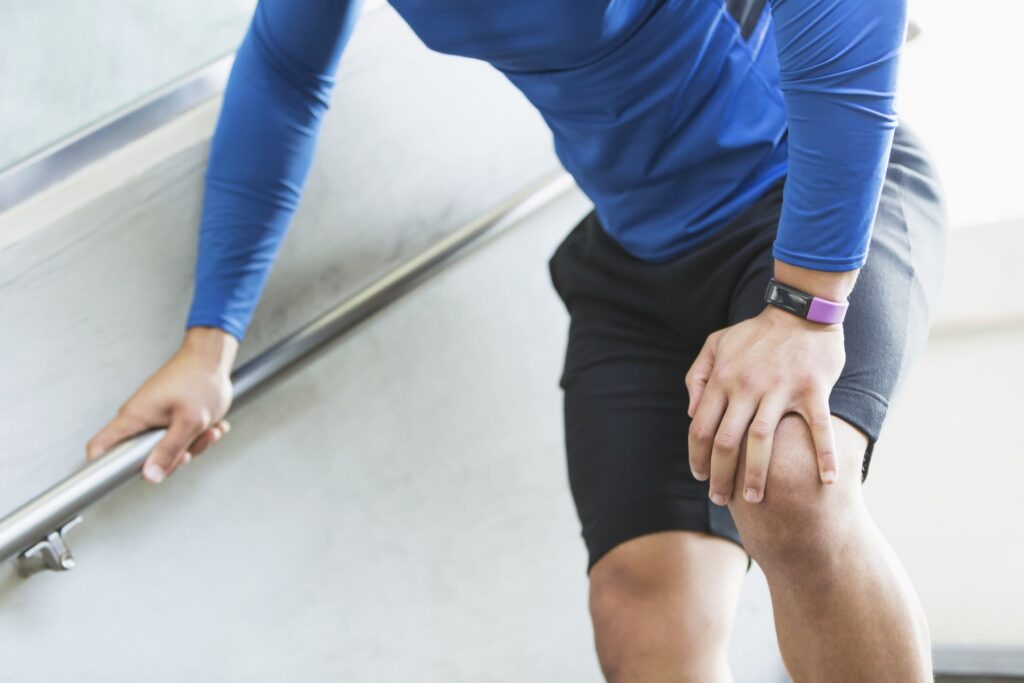Experiencing knee pain when going down stairs is a common issue that affects many people.
It is often more common during the climb down phase because of the increased force exerted on the knee joint, which can be up to several times an individual’s body weight.
Identifying the cause of knee pain is crucial as it can be a symptom of various underlying conditions, from the degeneration of cartilage to issues with the kneecap or surrounding structures.
Understanding the structure of the knee and the types of stresses it endures can provide insight into the cause of the pain
While some people may find relief through self-care and exercises aimed at increasing strength and flexibility, others may require professional intervention.
Early diagnosis and treatment are key to managing symptoms and improving knee health.
Key Points
Knee pain while descending stairs can indicate underlying knee conditions.
The Knee endures significant stress during stair descent, which can exacerbate pain.
- Professional diagnosis and targeted treatment are key for effective management.
Understanding Knee Anatomy and Pain
When discussing knee pain, particularly when coming down stairs, it is essential to consider the complex structures and common issues of the knee.
An understanding of knee anatomy and the common causes of its pain are important for recognising symptoms and seeking appropriate treatment.
Knee Structures and Function
The knee joint is a hinge joint that connects the thigh bone (femur) to the shinbone (tibia).
The Patella, commonly known as the ‘kneecap’, sits at the front of the knee and provides protection as well as facilitating movement.
The joint is held together by strong tendons and ligaments,
Muscles enable the Knee to extend and bend, playing a pivotal role in movement.
Cartilage, particularly the Meniscus, acts as a cushion and helps to distribute weight across the knee.
- Tendons: The Quadriceps Tendon that connects the quadriceps muscle to the patella, and the patellar tendon that ties the patella to the shinbone, crucially contribute to knee stability.
Common Causes of Knee Pain
Knee pain while going down stairs can often be attributed to issues within the knee’s complex structure.
Patellofemoral pain syndrome (PFPS), also referred to as Runner’s knee, is a condition causing pain around or under the kneecap due to problems with how the patella moves over the knee joint.
Degeneration of cartilage due to arthritis can lead to friction and pain in the knee, as the natural cushioning is worn away.
Overuse or sudden trauma can inflame or damage the tendons and result in pain which is exacerbated by the pressure of descending stairs.
- Muscle weakness or imbalances can negatively affect the stability and function of the knee joint, leading to discomfort or injury.
Understanding the interplay of these components is key to addressing the roots of knee pain effectively.
Risk Factors for Knee Pain When Descending Stairs
Descending stairs can lead to knee pain for various reasons. It’s important to identify risk factors that cause or contribute to it.
Physical and Lifestyle Contributors
Age: Older individuals often have a higher incidence of knee pain when going down stairs due to natural wear and tear of the joints.
Muscle Weakness: Weak quadriceps and hamstrings can place additional strain on the knee joint.
Previous Knee Pain: A history of knee pain can indicate an increased likelihood of experiencing pain when descending stairs.
Sex: Women may experience knee pain more frequently than men, in part due to anatomical differences.
- Flat Feet: Individuals with flat feet or overpronation may be more at risk due to the Misalignment and impact on the knee during flexion and extension.
Medical Conditions That Increase Risk
Arthritis: Conditions like osteoarthritis can cause knee pain when descending stairs due to joint degeneration.
Injury: Prior knee injuries, such as ligament tears, can predispose individuals to knee pain in situations like stair descent.
Weak Muscles: Weakness in stabilising muscles around the knee can contribute to pain and instability.
Diagnostic Process for Knee Pain
When diagnosing knee pain, a doctor typically conducts a thorough physical examination and may request imaging and tests to determine the underlying cause of the symptoms.
Physical Examination
The first step in the diagnostic process is a physical examination, where the doctor assesses the knee for signs of swelling, redness, and warmth that may indicate inflammation or infection.
They will also look for any visible abnormalities, such as a dislocated kneecap.
During this exam, the patient may be asked to perform movements to understand the range of motion and to identify specific movements that trigger pain or discomfort.
Imaging and Tests
Common imaging techniques include:
X-rays: Used to detect bone fractures and degenerative joint disease.
MRI (Magnetic Resonance Imaging): Provides detailed images of ligaments, tendons, and cartilage.
- Ultrasound: Visualise soft tissue structures in and around the knee joint.
In some cases, further diagnostic tests, such as blood tests or arthroscopy (a procedure where a camera is inserted into the joint space), may be recommended.
These help to evaluate the presence of joint disorders or to extract joint fluid for analysis, which can be useful in diagnosing infections or gout.
Treatment Options and Self-Care
When managing knee pain during stair descent, it’s important to consider a combination of medical treatments and home remedies to alleviate symptoms and prevent further injury.
Medical Interventions
They have access to various medical interventions that can help address the root causes of their knee pain.
Physical therapy is a cornerstone treatment, providing tailored exercises that strengthen the knee joint and improve flexibility. Sometimes a physician may recommend specific medications, such as ibuprofen, to reduce inflammation and pain.
Injections
In more severe cases, injections may be used as a treatment for knee pain. These can include corticosteroids to quickly bring down swelling and hyaluronic acid to lubricate the knee joint, potentially improving mobility and reducing discomfort.
Home Remedies and Lifestyle Adjustments
RICE Protocol
Rest: Avoid activities that put undue stress on the knee joint.
Ice: Apply cold packs for short periods multiple times a day to reduce swelling.
Compression: Use an elastic bandage or a knee sleeve for added support and to keep swelling under control.
- Elevation: Keep the knee elevated above heart level to decrease swelling.
Self-care Measures
Exercise: Pursue low-impact activities like swimming or cycling to maintain joint health without straining the knee.
Weight Management: Maintain a healthy body weight to reduce pressure on the knees.
- Footwear: Choose supportive shoes that provide cushioning during movement.
Exercises for Strengthening and Flexibility
Exercises focusing on both strengthening and flexibility can help alleviate knee pain experienced while descending stairs.
These exercises target the quadriceps and surrounding muscles to build strength, while stretching techniques can relieve tightness and increase range of motion.
Stretching Exercises
Hamstring Stretch:
Technique: Stand and place one foot on a higher surface, such as a step. Lean forward gently from the hips, keeping the spine straight until a stretch is felt along the back of the thigh.
- Frequency: Hold for 30 seconds, then switch legs.
Calf Stretch:
Technique: Face a wall with one foot in front of the other. Keep the back heel on the ground and lean forward until there is a stretch in the calf of the back leg.
- Frequency: Hold for 30 seconds, switch legs, and repeat.
Strengthening Exercises
Quadriceps Set:
Technique: Sit with legs extended in front. Tighten the quadriceps by pushing the knees down onto the floor. Ensure the back is straight.
- Frequency: Hold each contraction for 5 seconds, aiming for three sets of 10 repetitions.
Step-Ups:
Technique: Stand in front of a step or bench. Step up onto it with one foot, then bring the other foot up to meet it. Step down one foot at a time and repeat. Focus on slow, controlled movements and maintain good posture.
- Frequency: Perform 10 repetitions on each leg.
Incorporating these exercises into a regular routine can build strength in the muscles that support the knee, reducing the sensation of weakness during activities such as stair descent.
In addition, selecting proper shoes with adequate support can further prevent discomfort and stiffness.
For those experiencing persistent pain, seeking advice from a Physical therapist may be useful to get a tailored exercise program and ensure optimal technique.
Frequently Asked Questions
When addressing knee discomfort during stair descent, it is crucial to consider both mitigation strategies and the underlying causes. Ensuring proper diagnosis and treatment can significantly enhance one’s quality of life.
What are the best methods to alleviate knee pain when descending stairs?
One may find relief from knee pain on stairs through strategies such as using a handrail for support, taking slower steps, and applying weight to the stronger leg. Additionally, wearing knee supports might provide stabilisation and pain reduction.
What could be causing discomfort in my knee only when descending, not ascending steps?
Pain in the knee when going downstairs but not upstairs is often due to issues such as patellofemoral pain syndrome. The increased load on the knee joint during the descent can exacerbate underlying conditions that may not be as problematic during ascent.
What are the recommended exercises for knee pain linked to descending stairs?
Exercises focused on strengthening the quadriceps, hamstrings, and calves can be beneficial for managing knee pain related to descending stairs. Physiotherapists often recommend controlled leg lifts and calf raises to enhance stability and support.
When should one be concerned about knee pain associated with stairs?
One should seek medical advice if knee pain on stairs is persistent, accompanied by swelling, or affects daily activities. Sharp, severe pain or signs of infection, such as redness or heat, warrant immediate attention..
Can Injections Help with Knee Pain When Walking Down stairs?
Yes, we believe that injections are able to help some patients who suffer from pain when walking down stairs.
At MyMSK Clinic in Manchester we first assess the patient to find out what course of treatment is most suitable for them. This usually involves a physical examination and an ultrasound scan to find the cause of the pain as accurately as possible.
If you would like to arrange a consultation with us please call us at 0333 772 9655 or visit our Online Booking Page.

